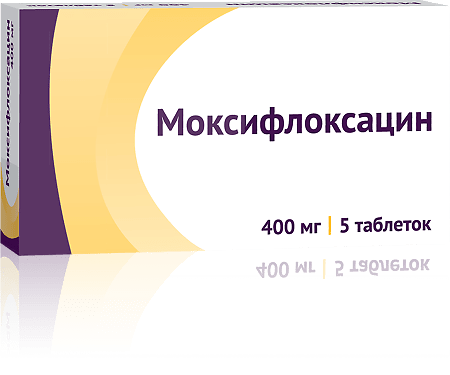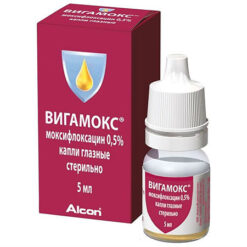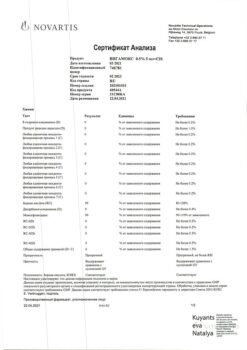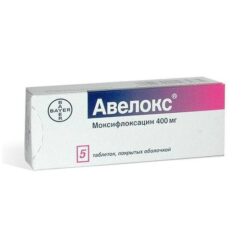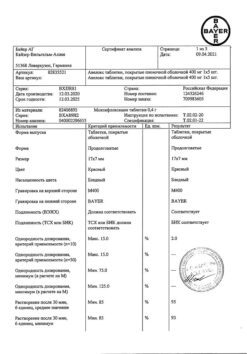No products in the cart.
Moxifloxacin, 400 mg 5 pcs
€12.54 €10.45
Description
Pharmacotherapeutic group
Antimicrobial agent – fluoroquinolone
ATX code
J01MA14
Pharmacodynamics:
The mechanism of action
Moxifloxacin is a broad-spectrum bactericidal antibacterial drug, 8-methoxifluoroquinolone. The bactericidal activity of the drug is due to the inhibition of bacterial topoisomerases II and IV which leads to disruption of DNA replication repair and transcription biosynthesis of the bacterial cell and, as a consequence, to death of microbial cells.
The minimal bactericidal concentrations of the drug are generally comparable to its minimal inhibitory concentrations.
Mechanisms of resistance
The mechanisms leading to the development of resistance to penicillins cephalosporins aminoglycosides macrolides and tetracyclines do not affect the antibacterial activity of moxifloxacin. Cross-resistance between these groups of antibacterial agents and moxifloxacin has not been observed. No cases of plasmid resistance have been observed so far either.
The overall incidence of resistance is very low (10-7-10-10).
Resistance to moxifloxacin develops slowly through multiple mutations. Repeated exposure of microorganisms to moxifloxacin in concentrations below the minimum inhibitory concentration (MIC) is accompanied by only a slight increase in the MIC. There are cases of cross-resistance to quinolones. Nevertheless, some gram-positive and anaerobic microorganisms resistant to other quinolones retain sensitivity to moxifloxacin.
It has been established that the addition to the structure of the molecule of moxifloxacin of a methoxy group in the C8 position increases the activity of moxifloxacin and reduces the formation of resistant mutant strains of Gram-positive bacteria. The addition of the bicycloamino group at the C7 position prevents the development of an active efflux mechanism of resistance to fluoroquinolones.
Moxifloxacin in vitro is active against a wide range of Gram- and Gram-positive microorganisms anaerobes acid-fast bacteria and atypical bacteria such as Mycoplasma spp. Chlamydia spp. Legionella spp. as well as bacteria resistant to β-lactam and macrolide antibiotics.
In two studies conducted on volunteers the following changes in the intestinal microflora were noted after oral administration of moxifloxacin: decrease in concentrations of Escherichia coli Bacillus spp. Bacteroides vulgatus Enterococcusspp. Klebsiella spp. as well as anaerobes Bifidobacterium spp. Eubacterium spp. Peptostreptococcus spp.These changes were reversible within two weeks. Clostridium difficile toxin was not detected.
The use of the drug Moxifloxacin is not recommended for the treatment of infections caused by strains of S. aureus resistant to methicillin (MRSA). In case of suspected or confirmed infections caused by MRSA the appropriate antibacterial agents should be administered.
For certain strains, the spread of acquired resistance may vary by geographic region and over time. Therefore, when testing strain sensitivity, it is desirable to have local information about resistance especially when treating severe infections.
If the area under the pharmacokinetic curve for concentration-time (AUC)/MIK90 is greater than 125 and (Cmax)/MIK90 is within 8-10 in inpatients, this suggests clinical improvement. In ambulatory patients, the values of these surrogate parameters are usually lower: AUC/MIK90 >30-40.
Pharmacokinetics:
Intake
In oral administration, moxifloxacin is absorbed rapidly and almost completely. Absolute bioavailability is about 91%.
The pharmacokinetics of moxifloxacin when administered in doses from 50 to 1200 mg once and also in 600 mg/day for 10 days is linear. The equilibrium state is reached within 3 days.
After a single administration of 400 mg of moxifloxacin the maximum concentration (Cmax) in blood is reached within 05-4 hours and is 31 mg/l.
After oral administration of 400 mg of moxifloxacin once daily, Cssmax and Cssmin are 32 mg/l and 06 mg/l, respectively.
When moxifloxacin is taken with food a slight increase in time to Cmax (by 2 hours) and a slight decrease in Cmax (approximately 16%) was noted, while the duration of absorption did not change. However, these data have no clinical significance and the drug can be used regardless of food intake.
Distribution
Moxifloxacin is rapidly distributed in the tissues and organs and binds with blood proteins (mainly with albumin) by about 45%. The volume of distribution is approximately 2 L/kg.
High concentrations of moxifloxacin exceeding those in the blood plasma are created in the lung tissue (including epithelial fluid of alveolar macrophages) in the nasal sinuses (maxillary and ethmoid sinuses) in nasal polyps in the foci of inflammation (in the contents of blisters in skin lesions). In interstitial fluid and saliva moxifloxacin is determined in free non-protein bound form at higher concentrations than in blood plasma. In addition, high concentrations of moxifloxacin are detected in the tissues of the abdominal cavity peritoneal fluid and female reproductive organs.
Metabolism
Moxifloxacin undergoes biotranformation of the second phase and is excreted by the kidneys and through the intestine both as unchanged and inactive sulpho compounds (M1) and glucuronides (M2). Moxifloxacin is not biotransformed by the microsomal cytochrome P450 system. Metabolites M1 and M2 are present in plasma concentrations lower than the parent compound. According to the results of preclinical studies it was proved that the mentioned metabolites do not have negative effects on the body in terms of safety and tolerability.
The elimination half-life of the drug is approximately 12 hours. Mean total clearance after administration at a dose of 400 mg is 179-246 ml/min. Renal clearance is 24-53 ml/min. This indicates partial tubular reabsorption of the drug. The mass balance of the parent compound and phase 2 metabolites is approximately 96-98%, indicating no oxidative metabolism. About 22% of a single dose (400 mg) is excreted unchanged by the kidneys about 26% – through the intestine.
Pharmacokinetics in different groups of patients
Age, sex and ethnicity
When studying pharmacokinetics of moxifloxacin in men and women the differences in AUC and Cmax were found in 33%. Absorption of moxifloxacin did not depend on gender. Differences in AUC and Cmax were due to weight differences rather than gender and are not considered to be clinically significant.
There were no clinically significant differences in the pharmacokinetics of moxifloxacin in patients of different ethnic groups.
Children
Pharmacokinetics of moxifloxacin in children has not been studied.
Renal failure
There are no significant changes in pharmacokinetics of moxifloxacin in patients with impaired renal function (including patients with creatinine clearance < 30 ml/min/ 173 m2) and in patients on continuous hemodialysis and long-term ambulatory peritoneal dialysis.
Hepatic impairment
There were no significant differences in moxifloxacin concentrations in patients with impaired liver function (Child-Pugh grades A and B) compared to healthy volunteers and patients with normal liver function.
Indications
Indications
Infectious and inflammatory diseases in adults caused by microorganisms sensitive to the drug:
– acute sinusitis;
– exacerbation of chronic bronchitis:
– uncomplicated skin and soft tissue infections;
– community-acquired pneumonia including community-acquired pneumonia whose causative agents are strains of microorganisms with multiple antibiotic resistance*;
– complicated infections of the skin and subcutaneous structures (including infected diabetic foot);
– complicated intra-abdominal infections including polymicrobial infections including intraperitoneal abscesses;
– uncomplicated pelvic inflammatory diseases (including salpingitis and endometritis).
* Streptococcus pneumoniae with multiple antibiotic resistance includes penicillin-resistant strains and strains resistant to two or more antibiotics from such groups as penicillins (at a minimum suppressive concentration ⥠2 mg/mL) second generation cephalosporins (cefuroxime) tetracyclines and trimethoprim/sulfamethoxazole macrolides.
The current official guidelines on the use of antibacterial agents must be taken into account.
Active ingredient
Active ingredient
Composition
Composition
Per 1 tablet:
Active ingredient:
moxifloxacin hydrochloride – 436.8 mg (in terms of moxifloxacin – 400 mg);
Excipients: microcrystalline cellulose type 102 -153 mg, croscarmellose sodium – 35 mg, mannitol – 60 mg, magnesium stearate – 7 mg, hypromellose (hydroxypropyl methylcellulose) – 23.5 mg, titanium dioxide-7.1 mg, macrogol-4000 – 6.6 mg, iron oxide red dye – 0.7 mg.
How to take, the dosage
How to take, the dosage
Recommended dosing regimen for moxifloxacin: 400 mg (one tablet) once daily for infections listed above. The recommended dose should not be exceeded.
The tablets should be swallowed whole without chewing and with plenty of water, regardless of meals.
The duration of treatment
The duration of treatment is determined by the location and severity of the infection and the clinical effect:
– Acute chronic bronchitis: 5-10 days.
– Acute sinusitis: 7 days.
– Uncomplicated infections of the skin and subcutaneous structures: 7 days.
– Community-acquired pneumonia: total duration of step therapy (intravenous injection followed by oral administration) is 7-14 days
– Complicated infections of skin and subcutaneous structures: The total duration of step therapy with moxifloxacin (intravenous followed by oral administration) is 7-21 days
– Complicated intra-abdominal infections: the total duration of step therapy (intravenous followed by oral administration) is 5-14 days.
– Uncomplicated pelvic inflammatory diseases: 14 days.
Do not exceed the recommended duration of treatment.
The duration of treatment with Moxifloxacin can be up to 21 days.
Patients of advanced age
There is no need to change the dosing regimen.
Children
The efficacy and safety of moxifloxacin in children and adolescents has not been established.
Hepatic impairment
Patients with impaired liver function do not require change in dosing regimen (for use in patients with cirrhosis, see section “Special Precautions”).
Patients with impaired renal function (including patients with severe renal impairment and creatinine clearance; 30 ml/min/173 m2) and patients on continuous hemodialysis and long-term ambulatory peritoneal dialysis do not require dosing changes.
Patient use in various ethnic groups
No change in dosing regimen is required.
Interaction
Interaction
When co-administered with atenololol ranitidine calcium-containing supplements theophylline cyclosporine oral contraceptives glibenclamide itraconazole digoxine morphine probenecid (no clinically significant interaction with moxifloxacin has been confirmed) no dose adjustment is required.
Drugs prolonging the QT interval
Possible additive effect of QT interval prolongation of moxifloxacin and other drugs which affect QT interval prolongation should be considered.
The co-administration of moxifloxacin and drugs that affect QT interval prolongation increases the risk of ventricular arrhythmias including polymorphic ventricular tachycardia (torsade de pointes).
The co-administration of moxifloxacin with the following drugs is contraindicated. which affect QT interval prolongation:
Antacids multivitamins and minerals
Taking moxifloxacin concomitantly with antacids multivitamins and minerals may lead to impaired absorption of moxifloxacin due to the formation of chelate complexes with multivalent cations contained in these drugs.
As a result, the concentration of moxifloxacin in plasma may be significantly lower than desired. In this regard antacids antiretroviral drugs (e.g. didanosine) and other drugs containing magnesium or aluminum sucralfate and other drugs containing iron or zinc should be used at least 4 hours before or 4 hours after oral administration of moxifloxacin.
Warfarin
When combined with warfarin prothrombin time and other parameters of blood clotting are not changed.
Change in INR value. In patients who received anticoagulants in combination with antibiotics, including with moxifloxacin there have been cases of increased anticoagulation activity of anticoagulants.
Risk factors are the presence of infectious disease (and associated inflammatory process) age and general condition of the patient. Although no interaction between moxifloxacin and warfarin was found in patients receiving concomitant treatment with these drugs the INR should be monitored and the dose of indirect anticoagulants should be adjusted if necessary.
Digoxin
Moxifloxacin and digoxin have no significant effect on the pharmacokinetic parameters of each other. When repeated doses of moxifloxacin were administered, maximum digoxin concentration was increased by approximately 30%, while the area under the concentration-time curve (AUC) and minimum digoxin concentration were not changed.
The simultaneous use of activated charcoal and moxifloxacin at a dose of 400 mg, systemic bioavailability of the drug is reduced by more than 80% due to the inhibition of its absorption. In case of overdose, the use of activated charcoal in the early stage of absorption prevents further increase in systemic exposure.
Special Instructions
Special Instructions
In some cases hypersensitivity and allergic reactions may develop already after the first use of the drug and the physician should be informed immediately. Very rarely even after the first use of the drug anaphylactic reactions may progress to life-threatening anaphylactic shock. In these cases the treatment with moxifloxacin should be cancelled and the necessary therapeutic measures (including anti-shock) should be conducted.
When using Moxifloxacin some patients may show prolongation of the QT interval. The drug Moxifloxacin should be used with caution in women and elderly patients. Since women compared to men have a longer QT interval they may be more sensitive to the drugs prolonging the QT interval. Older patients are also more susceptible to QT interval medications.
Long QT interval prolongation is associated with an increased risk of ventricular arrhythmias including polymorphic ventricular tachycardia.
The degree of QT interval prolongation may increase with increasing drug concentration, so the recommended dose should not be exceeded. However, in patients with pneumonia a correlation between plasma concentration of moxifloxacin and prolongation of the QT interval was observed. Lengthening of the QT interval is associated with an increased risk of ventricular arrhythmias including polymorphic ventricular tachycardia. None of the 9,000 patients receiving Moxifloxacin had cardiovascular complications and fatalities associated with prolongation of the QT interval. However, in patients with conditions predisposing to arrhythmias when using Moxifloxacin the risk of ventricular arrhythmias may increase.
In this regard, the drug Moxifloxacin is contraindicated in:
The drug Moxifloxacin should be used with caution:
When taking Moxifloxacin it was reported about the cases of fulminant hepatitis potentially leading to liver failure (including fatal cases) (see section “Adverse effects”). The patient should be informed that in case of symptoms of liver failure it is necessary to consult a physician before continuing treatment with the drug Moxiflaxacin.
When taking Moxifloxacin it was reported about the cases of bullous skin lesions such as Stevens-Johnson syndrome or toxic epidermal necrolysis (see section “Adverse effects”). The patient should be informed that in case of symptoms of lesions of the skin or mucous membranes it is necessary to consult a physician before continuing treatment with Moxiflaxacin.
The use of quinolone drugs is associated with a possible risk of seizures. The drug Moxifloxacin should be used with caution in patients with diseases of the CNS and with the conditions suspicious of CNS involvement predisposing to the occurrence of seizures or lowering the threshold for seizure activity.
The use of broad-spectrum antibacterial agents including Moxifloxacin is associated with the risk of pseudomembranous colitis. This diagnosis should be kept in mind for patients who have severe diarrhea during treatment with moxifloxacin. In this case, appropriate therapy should be prescribed immediately. Agents inhibiting intestinal peristalsis are contraindicated in the development of severe diarrhea.
The drug Moxifloxacin should be used with caution in patients with myasthenia gravis due to possible exacerbation of the disease.
The therapy with quinolones including moxifloxacin can lead to tendinitis and tendon rupture especially in elderly patients receiving glucocorticosteroids. At the first symptoms of pain or inflammation at the site of injury the drug should be discontinued and the affected limb should be unloaded.
Photosensitivity reactions have been reported with quinolones. However, during the preclinical and clinical studies, as well as during the use of Moxifloxacin in practice photosensitivity reactions were not observed. Nevertheless, patients receiving moxifloxacin should avoid direct sunlight and ultraviolet light.
The use of the drug in the form of tablets for oral administration is not recommended in patients with complicated inflammatory disease of the pelvic organs (e.g., associated with tubo-ovarian or pelvic abscesses).
The use of moxifloxacin is not recommended for the treatment of infections caused by strains of Staphylococcus aureus resistant to methicillin (MRSA). In case of suspected or confirmed MRSA infections, treatment with appropriate antibacterial agents should be prescribed (see section “Pharmacodynamics”).
The ability of the drug Moxifloxacin to inhibit the growth of mycobacteria may be the cause of in vitro interaction of moxifloxacin with the test for Mycobacterium spp. leading to false-negative results in the analysis of samples from patients who were treated with Moxifloxacin during this period.
In patients treated with quinolones including Moxifloxacin there have been cases of sensory or sensorimotor polyneuropathy resulting in paresthesias, hypoesthesias, dysesthesias or weakness. Patients who are treated with Moxifloxacin should be warned about the need for immediate medical attention before continuing treatment in case of symptoms of neuropathy including pain, burning, tingling, numbness or weakness (see section “Side effects”).
Psychiatric reactions may occur even after the first use of fluoroquinolones including moxifloxacin. In very rare cases, depression or psychotic reactions progress to suicidal thoughts and behavior with a tendency to self-harm. including suicide attempts (see section “Side effects”). In the case of such reactions the drug Moxifloxacin should be withdrawn and the necessary measures should be taken. Caution should be exercised when using the drug Moxifloxacin by patients with psychosis and/or with psychiatric diseases in the anamnesis.
Because of the high prevalence and increasing incidence of infections caused by Neisseria gonorrhoeae resistant to fluoroquinolones during the treatment of patients with pelvic inflammatory diseases should not be conducted monotherapy with moxifloxacin except for cases when the presence of resistant to fluoroquinolones N. gonorrhoeae is excluded. If there is no way to exclude the presence of fluoroquinolone-resistant N. gonorrhoeae, it is necessary to address the issue of supplementing empirical therapy with moxifloxacin with an appropriate antibiotic that is active against N. gonorrhoeae (eg, cephalosporin).
Dysglycemia
As with other fluoroquinolones. during the use of Moxifloxacin changes in blood glucose concentration including hypo-and hyperglycemia were observed. During the treatment with Moxifloxacin dysglycemia occurred mainly in elderly patients with diabetes receiving concomitant therapy with oral hypoglycemic agents (e.g., sulfonylureas) or insulin. During treatment in patients with diabetes mellitus, close monitoring of blood glucose concentrations is recommended (see section “Side effects”).
Fluoroquinolones including moxifloxacin may impair the ability of patients to drive and engage in other potentially dangerous activities requiring increased attention and rapid psychomotor reactions due to the effect on the CNS.
Contraindications
Contraindications
– Hypersensitivity to moxifloxacin. other quinolones or any other component of the drug;
– Age under 18 years;
– pregnancy and lactation;
– history of tendon pathology developed as a result of treatment with quinolone antibiotics;
– in preclinical and clinical studies after moxifloxacin administration changes in electrophysiological parameters of the heart were observed manifested by prolongation of QT interval. Due to this fact, the use of moxifloxacin is contraindicated in patients of the following categories: congenital or acquired documented prolongation of the QT interval electrolyte disorders especially uncorrected hypokalemia; clinically significant bradycardia; clinically significant heart failure with reduced left ventricular ejection fraction; the presence of a history of rhythm disorders accompanied by clinical symptomatology;
– Moxifloxacin should not be used with other QT interval prolonging drugs.
– Due to the presence of lactose in the drug its administration is contraindicated in congenital lactose intolerance deficiency of lactase glucose-galactose malabsorption;
– Due to limited clinical evidence, the use of moxifloxacin is contraindicated in patients with impaired liver function (class C according to the Child-Pugh classification) and in patients with transaminases elevated more than five times the upper limit of normal.
– In diseases of the CNS (including. Suspicious of CNS involvement) predisposing to seizures and lowering the seizure threshold;
– In patients with psychosis and/or a history of psychiatric illness;
– In patients with potentially proarrhythmic conditions (especially in women and elderly patients) such as acute myocardial ischemia and cardiac arrest;
– in myasthenia gravis;
– in patients with cirrhosis;
– when concomitantly taken with potassium-lowering drugs;
– in patients with a genetic predisposition or actual presence of glucose-6-phosphate dehydrogenase deficiency.
Side effects
Side effects
Infectious diseases: often – fungal superinfections.
Hematopoietic system: infrequent – anemia, leukopenia, neutropenia, thrombocytopenia, thrombocythemia, prolongation of prothrombin time/increase of INR; rarely – changes in thromboplastin concentration; very rare – increase of prothrombin concentration/reduction of INR.
The immune system: infrequent – allergic reactions, urticaria, pruritus, rash, eosinophilia, rare – anaphylactic/anaphylactoid reactions, angioedema, including laryngeal edema (potentially life-threatening), very rare – anaphylactic/anaphylactoid shock (including potentially life-threatening).
Metabolism: infrequent – hyperlipidemia; rare – hyperglycemia, hyperuricemia; very rare – hypoglycemia.
Psychiatric disorders: infrequent – anxiety, psychomotor hyperreactivity, agitation; rare – emotional lability, depression, hallucinations; very rare – depersonalization, psychotic reactions (potentially manifested in behavior with tendency to self-harm, such as suicidal thoughts or suicide attempts).
Nervous system disorders: Frequent – dizziness, headache; infrequent – paresthesias, dysesthesias, disorders of taste sensitivity (including in very rare cases aguesia), confusion, disorientation, sleep disorders, tremor, vertigo, somnolence; Rarely, hypoesthesia, olfactory disturbances (including anosmia), atypical dreams, coordination disorders (including gait disturbances due to dizziness or vertigo, very rarely leading to injuries from falling, especially in elderly patients), convulsions with various clinical manifestations (includingincluding “grand mal” seizures), attention disorders, speech disorders, amnesia, peripheral neuropathy, polyneuropathy; very rarely, hyperesthesia.
VIight: infrequent – visual disturbances (especially in CNS reactions); very rare – transient loss of vision (especially in CNS reactions).
Hearing organ: rare – tinnitus, hearing impairment, including deafness (usually reversible).
Cardiovascular system disorders: frequent – prolongation of the QT interval in patients with concomitant hypokalemia; infrequent – prolongation of the QT interval, palpitations, tachycardia, vasodilation; rare – increased BP, decreased BP, syncope, ventricular tachyarrhythmias; very rarely – nonspecific arrhythmias, polymorphic ventricular tachycardia (pirouette type), cardiac arrest (mainly in patients with conditions predisposing to arrhythmias, such as clinically significant bradycardia, acute myocardial ischemia).
Respiratory system disorders: infrequent – dyspnea, asthmatic condition.
Digestive system disorders: frequent – nausea, vomiting, abdominal pain, diarrhea; infrequent – decreased appetite and reduced food intake, constipation, dyspepsia, flatulence, gastroenteritis (except erosive gastroenteritis), increased amylase activity; rare – dysphagia, stomatitis, pseudomembranous colitis (in very rare cases associated with life-threatening complications).
Liver and biliary tract disorders: frequent – increased activity of liver transaminases; infrequent – liver dysfunction (including increased LDH activity), increased bilirubin concentration, increased GGT and alkaline phosphatase activity; rare – jaundice, hepatitis (mostly cholestatic); very rare – fulminant hepatitis, potentially leading to life-threatening liver failure (including fatal cases).
Skin and subcutaneous tissue disorders: very rare – bullous skin reactions, such as Stevens-Johnson syndrome or toxic epidermal necrolysis (potentially life-threatening).
Muscular system disorders: infrequent – arthralgia, myalgia; rare – tendinitis, increased muscle tone and cramps, muscle weakness; very rare – arthritis, tendon ruptures, gait disturbance due to musculoskeletal system damage, increased symptoms of myasthenia.
Urinary system disorders: infrequent – dehydration (caused by diarrhea or reduced fluid intake); rarely – renal impairment, renal failure due to dehydration, which can lead to renal damage, especially in elderly patients with pre-existing renal impairment.
Local reactions: often – reactions at the site of injection/infusion.
General reactions: infrequent – general malaise, nonspecific pain, sweating.
The incidence of the following adverse reactions was higher in the group receiving step therapy: frequently – increase in GGT activity; infrequently – ventricular tachyarrhythmias, arterial hypotension, edema, pseudomembranous colitis (in very rare cases associated with life-threatening complications), convulsions with various clinical manifestations (including “grand mal” seizures).including “grand mal” seizures), hallucinations, renal dysfunction, and renal failure (as a result of dehydration, which may lead to renal damage, especially in elderly patients with pre-existing renal dysfunction).
Overdose
Overdose
Pregnancy use
Pregnancy use
The safety of moxifloxacin use during pregnancy has not been established and its use is contraindicated. Cases of reversible joint damage in children receiving some quinolones have been described, but there have been no reports of this effect in the fetus (when used by the mother during pregnancy).
Reproductive toxicity has been shown in animal studies. The potential risk to humans is unknown.
Like other quinolones. moxifloxacin causes cartilage damage of large joints in premature animals.
In preclinical studies it was found that a small amount of moxifloxacin is excreted into breast milk. There are no data on its use in women during lactation. Therefore, the use of moxifloxacin during breastfeeding is contraindicated.
Similarities
Similarities
Additional information
| Shelf life | 2 years. Do not use after the expiration date printed on the package. |
|---|---|
| Conditions of storage | In a light-protected place at a temperature not exceeding 25 ° C. Store out of the reach of children. |
| Manufacturer | Ozon, Russia |
| Medication form | pills |
| Brand | Ozon |
Other forms…
Related products
Buy Moxifloxacin, 400 mg 5 pcs with delivery to USA, UK, Europe and over 120 other countries.

